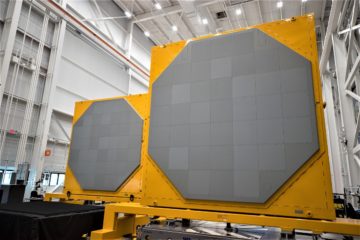NMESIS recently took part in Large Scale Exercise (LSE) 21. During the exercise, NMESIS was first deployed via C130 transport aircraft and LCAC, and then took part in a sinking exercise (SINKEX) in which the system fired Naval Strike Missiles (NSM) against the decommissioned guided-missile frigate Ingraham. According to the USMC, this was the second guided flight firing for the system.
NMESIS integrates an unmanned variant of the Joint Lightweight Tactical Vehicle, the NSM and the NSM fire control system used by the U.S. Navy. To learn more about the NMESIS program, Naval News contacted Marine Corps Systems Command.

Naval News: Was NMESIS’ test during LSE 21 representative of an operational scenario ?
Kelly Flynn – Public Affairs Specialist – Marine Corps Systems Command (USMC): The exercise represented multiple operational activities that would make up a typical operational scenario.
Naval News: Was this the first time the NMESIS was test fired following air and sea transit?
USMC: This was the first time we conducted both firing and deployment activities in the same exercise.
Naval News: Can you say when NMESIS will be formally fielded?
USMC: The 3rd Marine Littoral Regiment will be operational with NMESIS at the end of FY23.
Naval News: How many NMESIS systems have been delivered by Raytheon to date?
USMC: Two systems of the latest LSE-21 configuration have been delivered.
Naval News: The program of record calls for how many systems to be delivered?
USMC: This information is still pre-decisional.
Naval News: Which platform provided the targeting information during LSE 21 and how (was it via Link 22, link 16) ?
USMC: We will not discuss specific tactics or capabilities at this time.
Naval News: Why is the launcher “unmanned” ? Is it because it is intended to be controlled by company (i.e. small) sized Marine units ? Or is it because NMESIS is intended to be deployed on remote islands or locations with no human operators on those islands ?
USMC: The launcher is remotely operated in order to enable a smaller, more expeditionary deployable capability. Additionally, remote firing position increases personnel survivability. Marine crews are still expected to be in the vicinity to provide security for the systems.
For the record, the USMC selection of Naval Strike Missiles from Raytheon was first announced in May 2019. The NMESIS was test fired for the first time during a “November 2020 live fire event “ which we first mentioned back in February 2021. We reached out to Raytheon to ask how the company managed to move so fast (i.e. get the system operational just 4 years after contract award) and what are the main challenges in the program. Randy Kempton, Naval Strike Missile program lead for Raytheon Missiles and Defense replied to Naval News:
“Ultimately it has been the collaboration – I’ve never seen a team work together so well or so closely. Our Marine Corps customers have done outstanding work articulating the program’s objectives—where the service wants to take the NMESIS system. That enabled us to step out with our industry partners to achieve some early successes that grew trust and confidence among all of our teammates—Navy, Marine Corps, and industry alike. In this environment, we’ve been able to make rapid progress, resolve challenges, and retire risks.”
NMESIS and Light Amphibious Warship (LAW)

In terms of concept of use, Naval News understands that NMESIS is very much related to the U.S. Navy’s strategy in the Pacific and to the new Light Amphibious Warship (LAW) program. As we reported previously, the LAW will be the “new strategy and tactic” to countering the Chinese Anti-Access/Area Denial island chains around the South China Sea.
LAW will be the platform of choice to deploy NMESIS on islands across the pacific in order to deter People’s Liberation Army Navy (PLAN or Chinese Navy) surface ships via sea denial thanks to the NSM anti-ship missiles.
Major General Tracy King, U.S. Marine Corp (USMC) said at SNA 2021:
“LAW will be a Force Multiplier that provides Fleet and Joint Force Commanders a purpose-built capability for naval forces to maintain a persistent presence to deter adversaries. We’re going to able to stay there. Think of it as a Lilly pad; think of a 21st Century LSM [Landing Ship Medium] from World War 2 […] LAW is not an auxiliary; it’s not a connector; it’s not a forcible-entry platform. It is a combatant that will enable persistent presence and enhance tactical mobility in the pursuit of sea denial,”
The U.S. Navy’s new Light Amphibious Warship (LAW) program envisions procuring a class of 24 to 35 new amphibious ships. The U.S. Navy envisions the first LAW being procured in FY2023. The U.S. Navy issued “concept design” contracts to five companies for the Light Amphibious Warship ahead of the Fiscal Year 2023 design selection for a total combined amount of less than $7.5 million. Fincantieri, Austal USA, VT Halter Marine, Bollinger and TAI Engineers were selected for the contracts.








